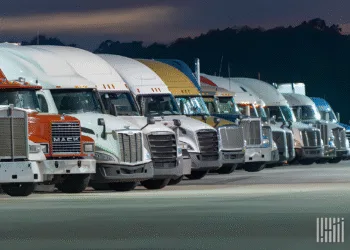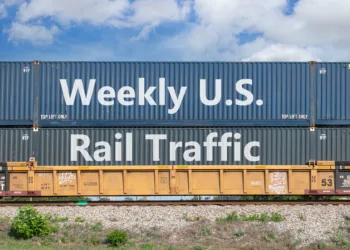Air cargo volume growth will be halved in 2025, but it will still be a good year for carriers behind continued ocean shipping delays, tight freighter capacity and strength in cross-border e-commerce, the International Air Transport Association forecast.
Cargo volumes are expected to reach 80 million tons, a 5.8% increase from 2024, the trade association said. Cargo demand this year has grown year over year between 10% and 13%, depending on whether it is measured by traffic (cargo ton kilometers) or tons, with the consensus growth rate at 12%. Volumes during the third quarter were second only to the fourth quarter of 2021, when the coronavirus pandemic supercharged airfreight shipping.
The growth projection closely aligns with recent predictions by other market watchers. Freight data provider Xeneta recently said air cargo demand will grow 4% to 6% next year, while capacity increases in the 4% to 5% range. Consultancy Rotate pegs demand growth at about 4%. And logistics giant DSV suggested air cargo growth could be flat.
“It should also be noted that the 2024 year-on-year growth rates have been off an overall weak 2023 market. So sustaining these double annual growth rates is going to become just a little bit harder,” said IATA economist Ghislaine Lang during an online media briefing last week.
The current fourth quarter is on track for a record high. The only reason it doesn’t appear as a normal peak season leading to holiday shopping events is that volumes have been strong all year, without any seasonal ebbs. In other words, demand this quarter could reach levels not seen since the pandemic-fueled boom in 2021 but sequentially since the summer upward activity has been less pronounced.
Industry analysts say pricing has remained rational in the face of heavy demand because businesses have been proactive about moving shipments ahead of the usual crunch time and executing short-term contracts for guaranteed space instead of booking on demand.
IATA forecast that air cargo traffic, a measure of combined weight and distance flown, for the full 2024 will grow 11.8% and flirt with the all-time high.
IATA’s outlook calls for member passenger and cargo airlines to achieve cargo revenue of $157 billion in 2025, up 5.4% from the current year. At that level, cargo will represent 15.6% of airlines’ total revenues compared to 12% in 2019. It said average yields should remain stable at 30% above pre-pandemic levels.
During the coronavirus pandemic, freighters became the dominant form of air cargo as passenger aircraft were largely sidelined. The ratio of freighter to belly traffic has since normalized to about 55/45 with the full recovery of global air travel, but demand for dedicated widebody freighters exceeds capacity as factory-built and converted freighters face production delays.
Most of the imbalance is in the trans-Pacific trade lane where the share of dedicated freighter capacity (89%) is higher today than at the height of the pandemic and belly capacity between the U.S. and China is still low because of diplomatic disputes. As lower-deck capacity moves away from China, all-cargo airlines have moved assets from other regions to the Asia-Pacific and the center of e-commerce activity.
Direct-to-consumer e-commerce shipments have been the primary driver of air cargo growth in recent years, with muted growth in other commodities. Experts attribute more than 50% of air cargo volumes out of Asia this year to e-commerce. The influx of large online marketplaces, executing direct-to-consumer fulfillment strategies from China, has elbowed out more traditional freight like apparel, electronics and automotive parts, and influenced the upward move in yields. The traditional B2B airfreight market is likely to rebound next year, supported by demand for semiconductors to power AI, advanced computer processing and electric vehicles, freight data provider Xeneta predicts in its 2025 air cargo outlook.
Global yields in October were about 50% higher than in 2019 and up 11% year over year, primarily because of rates on westbound routes out of Asia and the Middle East to Europe and the Americas. The strengthening of average rates led IATA to forecast a smaller-than-expected decline of -3.5% for 2024 and flat yields for 2025 – but still one-third above pre-pandemic levels.

The air logistics sector has also benefited from businesses pivoting to air transport because of attacks pushing container vessels away from the Suez Canal and around Africa. Red Sea diversions continue to result in delays and are putting upward pressure on ocean rates on key trade corridors, with global spot prices up 200% year over year. Escalation in ocean rates has narrowed the price gap with airfreight, which is now only five times more expensive than ocean shipping versus 10 to 15 times more expensive historically.
Demand has been strong on all trade corridors, with some growth on secondary lanes attributed to logistics providers routing goods through the Middle East, Africa and Europe to take advantage of transshipment options rather than simply using trans-continental options, said Lang.
Meanwhile, aircraft cargo capacity continues to grow but at a slower pace than demand. With China fully reopening borders and passenger airlines resuming full international schedules, aircraft cargo capacity will end the year up 9.6% from 2023. Next year, capacity growth will decelerate to 6.4%, IATA said. The way the forecasts stack up suggests there could be more capacity entering the market than demand, which could put downward pressure on rates.
The overall economy remains favorable for air cargo, with the World Trade Organization predicting merchandise trade growth of 3% (on par with GDP) in 2025, up from 2.7% this year. But the growth trend could be impacted by several gathering storm clouds.
U.S. President-elect Donald Trump has already threatened widespread tariffs, which is likely to trigger retaliation from other countries. A trade war will be inflationary and dampen consumer spending, economists say. Meanwhile, an increased regulatory focus on import security and duty-free e-commerce shipments could also act as a drag on international air shipping.
Industry stakeholders will be watching how airfreight demand responds if ocean shipping rates drop back to pre-pandemic levels, especially if the Red Sea conflict is resolved, or if e-commerce respond to regulatory pressure by moving to a hybrid model based on a mix of direct fulfillment by air and pre-stocking forward warehouses in the U.S. and other markets.
Conversely, the air logistics sector could see a spike in shipments to the United States if a threatened strike by dockworkers shuts down U.S. East Coast and Gulf Coast ports, forcing businesses to make alternative import/export plans for high-value goods and critical industrial components.
Airline industry outlook as a whole
The overall airline industry is expected to hit the $1 trillion revenue mark next year after rising 6.2% to $965 billion this year, a gain that will help deliver net profit of $36.6 billion. That’s an improvement from the estimated $31.5 billion net profit in 2024 and 3.3% margin, IATA said. Average net profit per passenger is anticipated to be $7.
Expenses are expected to grow by 4% to $940 billion, before interest and taxes.
The outlook for better financial performance is a function of lower jet fuel prices and efficiency gains. The price of jet fuel fell to $70 per barrel in September for the first time since the start of the Russia-Ukraine War nearly three years ago, due to oversupply by the United States. IATA said jet fuel is expected to average $87 a barrel (down from $99 a barrel in 2024), based on a jet fuel crack spread of $12 per barrel and a crude oil price of $75 per barrel (Brent). As a result, airlines’ cumulative fuel spend is expected to be $248 billion, a decline of 4.8% despite a 6% rise in the amount of fuel expected to be consumed. Fuel is expected to account for 26.4% of operating costs in 2025, down from 29% in 2024.
Further gains are being stymied by supply chain troubles at aircraft and engine manufacturers, which is limiting airlines’ ability to modernize or grow their fleets and driving up costs in areas such as aircraft leasing and maintenance.
Net profitability will also be squeezed as airlines are expected to exhaust their tax losses carried forward from the pandemic era, leading to an increase in tax rates in 2025, IATA said.
A primary area for cost escalation is labor as pilots, flight attendants and mechanics achieved sizable wage increases in recent contracts. In 2025, labor costs are expected to total $253 billion, up 7.6% from 2024. With productivity gains, however, average labor unit costs are likely to rise by only 0.5% in 2025 compared to 2024.
Overall nonfuel unit costs rose 1.3% in 2024 for a total of $643 billion. Nonfuel unit cost increases in 2025 are expected to inch up to $692 billion.
The return of Trump as president is creating uncertainty for the airline sector. On the one hand, tariffs could lead to slower economic growth, but a more business-friendly Trump approach to regulation and taxation could help U.S. carriers. It is also unclear whether a Trump administration will support production incentives for sustainable aviation fuel.
Profits “will be hard-earned as airlines take advantage of lower oil prices while keeping load factors above 83%, tightly controlling costs, investing in decarbonization, and managing the return to more normal growth levels following the extraordinary pandemic recovery. All these efforts will help to mitigate several drags on profitability which are outside of airlines’ control, namely persistent supply chain challenges, infrastructure deficiencies, onerous regulation and a rising tax burden,” said IATA Director General Willie Walsh.
“The buffer between profit and loss, even in the good year that we are expecting of 2025, is just $7 per passenger. With margins that thin, airlines must continue to watch every cost and insist on similar efficiency across the supply chain — especially from our monopoly infrastructure suppliers who all too often let us down on performance and efficiency,” he said.
Click here for more FreightWaves/American Shipper stories by Eric Kulisch.
RELATED READING:
Analysts predict air cargo bull market will cool 50% in 2025
‘No big bang’ for peak season air cargo business
The post Growth in air cargo demand to decelerate in 2025, IATA says appeared first on FreightWaves.






















